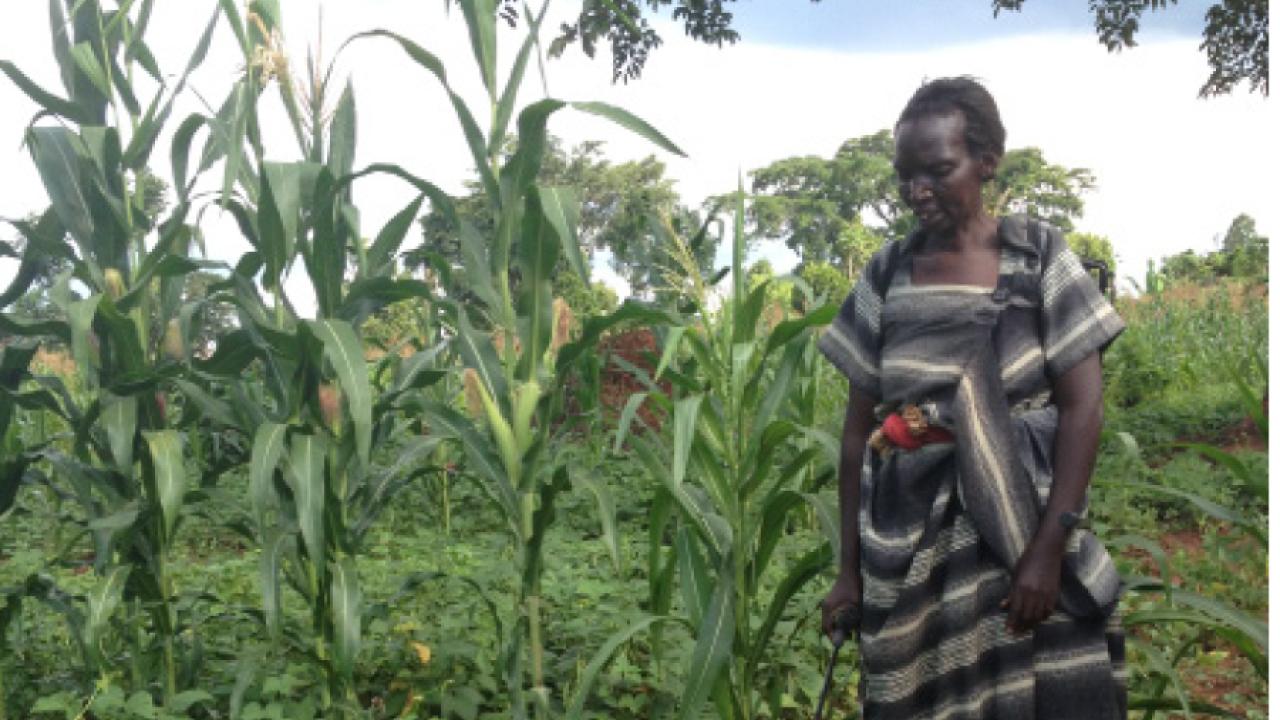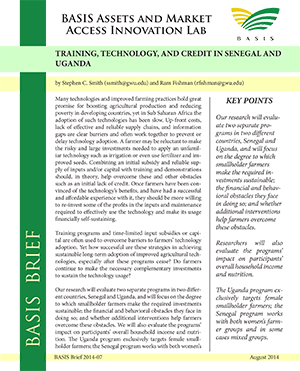
Many technologies and improved farming practices hold great promise for boosting agricultural production and reducing poverty in developing countries, yet in Sub Saharan Africa the adoption of such technologies has been slow. Up-front costs, lack of effective and reliable supply chains, and information gaps are clear barriers and often work together to prevent or delay technology adoption. A farmer may be reluctant to make the risky and large investments needed to apply an unfamiliar technology such as irrigation or even use fertilizer and improved seeds.
Key Points
- Our research will evaluate two separate programs in two different countries, Senegal and Uganda, and will focus on the degree to which smallholder farmers make the required investments sustainable; the financial and behavioral obstacles they face in doing so; and whether additional interventions help farmers overcome these obstacles.
- Researchers will also evaluate the programs’ impact on participants’ overall household income and nutrition.
- The Uganda program exclusively targets female smallholder farmers; the Senegal program works with both women’s farmer groups and in some cases mixed groups.
 Combining an initial subsidy and reliable supply of inputs and/or capital with training and demonstrations should, in theory, help overcome these and other obstacles such as an initial lack of credit. Once farmers have been convinced of the technology’s benefits, and have had a successful and affordable experience with it, they should be more willing to re-invest some of the profits in the inputs and maintenance required to effectively use the technology and make its usage financially self-sustaining.
Combining an initial subsidy and reliable supply of inputs and/or capital with training and demonstrations should, in theory, help overcome these and other obstacles such as an initial lack of credit. Once farmers have been convinced of the technology’s benefits, and have had a successful and affordable experience with it, they should be more willing to re-invest some of the profits in the inputs and maintenance required to effectively use the technology and make its usage financially self-sustaining.
Training programs and time-limited input subsidies or capital are often used to overcome barriers to farmers’ technology adoption. Yet how successful are these strategies in achieving sustainable long-term adoption of improved agricultural technologies, especially after these programs cease? Do farmers continue to make the necessary complementary investments to sustain the technology usage?
Our research will evaluate two separate programs in two different countries, Senegal and Uganda, and will focus on the degree to which smallholder farmers make the required investments sustainable; the financial and behavioral obstacles they face in doing so; and whether additional interventions help farmers overcome these obstacles. We will also evaluate the programs’ impact on participants’ overall household income and nutrition. The Uganda program exclusively targets female smallholder farmers; the Senegal program works with both women’s farmer groups and in some cases mixed groups.
Often, research findings from agriculture and rural development in Africa are not considered by national policy makers. To establish this connection, we are working closely with the Economic Policy Research Center (EPRC) in Uganda, in conjunction with the Brookings Institution Africa Growth Initiative. Initially, EPRC will provide policy analysis to put the projects and experiments in context, and assist with identifying major background trends that affect the interpretation of field results, including those regarding food security and usage of improved seeds. About three years down the road, EPRC will assist with active policy outreach to disseminate our results and conclusions.
Drip Irrigation in Senegal
In Senegal we will evaluate how cooperative management impacts a drip irrigation program for vegetable production. Drip irrigation is widely considered a promising technology for sustainable agriculture, as it can achieve a simultaneous yield increase and a decrease in water, fertilizer and pesticide usage, resulting in a high rate of return on investment.
Water scarcity, and especially the labor required to fetch water and carry it to one’s plot, is a major constraint that drip irrigation can help address. Thus its potential for poverty alleviation is great. However, while effective in controlled conditions on demonstration farms, its adoption by smallholder farmers in Sub-Saharan Africa has been is limited. In fact, efforts to introduce drip irrigation in the region have often resulted in underperformance, followed by abandonment. The reasons for this are unclear, as little rigorous impact evaluation has been conducted.
Program details: Senegal
Our research will analyze the impacts and sustainability of PAPSEN, a project by the Senegalese, Italian and Israeli governments (through Italian Cooperation and MASHAV) to promote irrigated vegetable cultivation in Senegal. At the heart of the program is the TechnoAgricultural Irrigation for Poverty Alleviation (TIPA) model, which combines drip irrigation with an input package, and has been proven in field trials to deliver high rates of return. According to prior field tests, by relaxing manual irrigation labor constraints, farmers may be able to increase their cultivated area and revenue during the dry seasons by fourfold or more.
The PAPSEN project will also provide intensive extension, input supply and marketing services to participating farmers. Over three years, a service center in Bambey will provide centralized training, demonstration, a reliable fertilizer supply, improved seeds and pesticides, and marketing support with PAPSEN funding. This funding will allow low-pressure drip systems to be installed on public land in participating villages at no cost. In addition, extension agents will make weekly plot monitoring visits.
Since drip irrigation is usually installed and more costeffective on plots of land much larger than those typically owned by smallholder farmers in Sub Saharan Africa, we will study a model that brings them together in groups that share the irrigation system, thus using it at an efficient scale. We will examine the impact of access to irrigation on incomes, time use, investments, and nutrition, both in the short term, and the degree to which they persist or diminish after the the program concludes.
Fertilizer and Improved Seed in Uganda
In 2014, BRAC Uganda began scaling back their program. The BRAC Uganda program promotes the use of improved seeds and fertilizer by individual farmers through demonstrations by ‘model farmers’ and a proactive supply of inputs through a network of village promoters. The project implementers have randomized which villages are removed from the program, allowing us to use a “reverse randomized controlled trial” methodology to assess program impacts.
This research has broad significance because many agricultural development initiatives are based on short-term training, subsidies, and grants; but we lack evidence on the long-term impact of such initiatives after external support phases out. Although financial sustainability is often an objective of aid projects, critics argue that in general the sustainability of poverty programs in Africa is a myth without continued assistance. Yet surprisingly, to our knowledge phase-out impacts have never been studied rigorously. Thus our aim is to help improve program development and policy design by evaluating the crucial issue of sustainability.
Program details: Uganda
Launched in August 2008, BRAC’s agriculture program seeks to increase fertilizer and improved seed usage and thus the productivity of low income, smallholder female farmers, by providing extension and a support network of model farmers and community agriculture promoters (CAPs).
In Uganda the program operates in 41 districts, engages 800 model farmers, who then train 40,000 general farmers. Model farmers receive six days of training in crop production techniques, new crop varieties and pest control, as well as follow-up refresher courses. Then, they provide a three-day training for the general farmers in their villages. CAPs were also selected from the same populations of poor and marginalized women to procure and sell improved seeds and fertilizers in the villages.
Anticipated Impacts
Senegal
A customized package of complementary inputs like improved seeds, fertilizer and pesticides are key to successful adoption, but under-investment in these inputs has also been identified as a pervasive problem plaguing earlier drip irrigation dissemination attempts. Low rates of input use can be attributed to liquidity constraints, knowledge gaps, and other behavioral factors.
To deal with an initial lack of funds, PAPSEN will provide inputs to farmers at no cost during the first harvest cycle. In subsequent seasons, farmers will pay the full costs of all inputs, or be excluded from further participation. By linking decisions on input use with overall project participation, and thus raising the costs of under-investment, project leaders expect that farmers will choose to follow expert advice instead of applying sub-optimal quantities of water and fertilizer.
To track and measure input use we will conduct three field surveys of farmers’ associations and individual households belonging to both treatment and control groups: a baseline survey, a midline survey two years into the project, and an endline survey during the fourth year of the project, about a year after the intervention has ceased. In addition, we will utilize detailed records of farmer-specific input use and seasonal yields collected by the project staff.
Drip irrigation is substantially less cost-effective for smallholders, and small plot size is clearly a key factor leading to dis-adoption. A natural approach to overcoming this obstacle is to install collective drip irrigation systems with farmers’ associations, which are common in Senegal especially with women farmers. Each group will enter a formal agreement with PAPSEN, and nominate a Village Animator, who will be trained to manage and operate the water supply and irrigation system.
While cooperative production models have a long tradition in agriculture due to their advantage in economies of scale, these models can also introduce challenges. In terms of a cooperative drip irrigation system, the coordination and collective action challenges related to system maintenance, which is crucial to the model’s sustainability, are especially difficult once external intervention withdraws.
Uganda
Are the effects of an agricultural extension program sustainable? BRAC’s plans to withdraw support from randomly selected villages provides a unique opportunity to study the complementarities between the program’s components (demonstration, training, and a subsidized, accessible supply chain) as well as the impacts of alternate forms of withdrawal. Support will be phased out, with one-third of the study villages randomly selected to receive services for an additional two years, after the other two thirds have had their programs phased out in differing stages. Accordingly, we will employ reverse RCT methods to examine the impacts of scaling back support for either model farmers, who provide training to general farmers, or CAPs, who provide agricultural inputs, and then both, as well the impact on long-term outcomes of prolonging the intervention for another two years.
When support for model farmers and/or CAPs are withdrawn, these farmers may or may not continue to engage in these operations. For example, CAPs may choose to operate a private enterprise to supply the village with seed. Even if they do not, seeds will still be available to farmers because they will be able to purchase them in other villages or trading centers. However, procuring them might become more costly due to increased travel times.
Accordingly, we will test the system’s sustainability across 1) activities, such as maintaining demonstration farms, maintenance of supply chains by independent farmers as private enterprises, savings, and utilization of credit facilities; 2) practices, such as technology adoption and improved seed and fertilizer use; and 3) impacts such as yields, incomes, and nutritional status.
This report is made possible by the generous support of the American people through the United States Agency for International Development (USAID). The contents are the responsibility of the Feed the Future Innovation Lab for Assets and Market Access at UC Davis and do not necessarily reflect the views of USAID or the United States Government.
